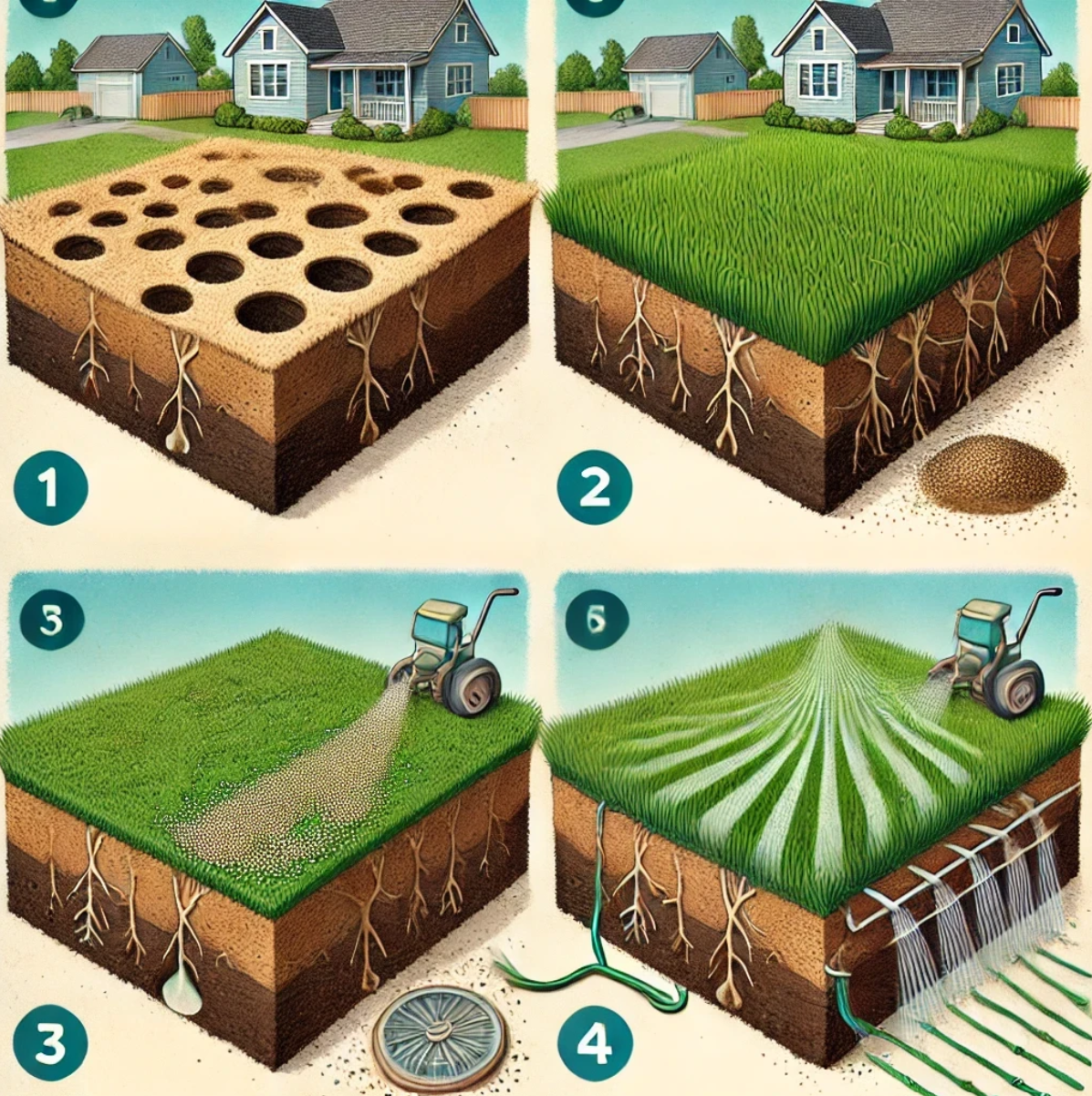This article is about reviving and salvaging a lawn. Even the best-kept lawns can hit a rough patch (literally). Maybe you’ve moved into a home where the lawn was already in bad shape, or perhaps a season of neglect, harsh weather, or pests have taken a toll on what was once a beautiful, green yard. Dead spots, thinning grass, weeds taking over, or bare patches where nothing seems to grow—these issues are all too common, especially in Southern climates where heat, drought, and lawn diseases can be persistent challenges.
But don’t worry—most lawn problems can be fixed with the right approach and a little patience. A struggling lawn doesn’t have to stay that way. Whether your grass has been damaged by an insect infestation, fungal disease, drought stress, or just years of poor maintenance, there’s almost always a way to bring it back to life. It might take some effort, but with the right knowledge and strategies, you can restore a patchy, unhealthy lawn into a thick, thriving carpet of green.
This post is all about diagnosing issues, repairing damage, and implementing renovation techniques to rejuvenate your lawn. You’ll learn how to identify the root causes of your lawn’s problems, whether they stem from soil imbalances, compaction, lack of nutrients, or environmental stressors. From simple fixes like aeration and overseeding to more intensive solutions like dethatching, regrading, or even total lawn replacement, we’ll cover the best strategies to revive your yard.

Diagnosing the Problem
Before jumping into solutions, it’s important to identify why the lawn is struggling. If you don’t address the underlying cause, the problem will likely return. Here are some common lawn issues and how to recognize them:
- Thinning or Bare Patches: If soil is visible between sparse grass, common causes include poor soil fertility, compaction, lack of sunlight, or insufficient water. If thinning mostly occurs under trees, it’s likely due to shade and root competition. Small random patches may indicate pet urine damage or grub infestations.
- Irregular Brown Patches: If patches of brown grass appear in an otherwise green lawn, potential culprits include fungal diseases, drought stress, or pest infestations. If the patches are straw-like and the grass pulls up easily, grubs or mole crickets could be to blame. For St. Augustine lawns, patches that yellow before turning brown could indicate chinch bugs.
- Overall Fading and Yellowing: A pale or yellow lawn often signals a nutrient deficiency, particularly nitrogen or iron. If centipede grass turns yellow, it may be suffering from iron chlorosis due to high soil pH or excessive fertilization.
- Weed Infestation: A high presence of weeds often means the grass is weak and not dense enough to crowd them out. Certain weeds thrive in specific conditions; for example, an over-limed lawn may encourage broadleaf weeds, while crabgrass flourishes in compacted or undernourished soil.
- Excess Thatch or Spongy Lawn: If the lawn feels excessively soft and spongy, there may be a thick thatch layer choking the grass. Thatch prevents proper root growth and can make grass more susceptible to drought stress and disease.
- Waterlogged or Mossy Areas: Standing water or excessive moss growth suggests poor drainage. Compacted soil or improper grading could be the cause. Moss also thrives in acidic soil, which may require pH correction.
If multiple factors are at play, tackling them systematically is key. Soil testing and turf diagnostics from local extension services can provide insights into underlying issues.
Fixing Common Issues
Soil Rehabilitation
A soil test can reveal nutrient deficiencies and pH imbalances. If pH is too low, applying lime can raise it, whereas sulfur can lower a high pH. Poor soil may need aeration and organic amendments like compost to improve structure and fertility.
Thatch Removal
Excess thatch can be addressed with dethatching or aeration. Dethatching machines remove the thick organic layer, while core aeration punches holes in the soil to allow for better water and nutrient absorption. Aeration also helps break down thatch naturally. Warm-season grasses tolerate dethatching well in late spring or early summer, but gentler aeration is preferable for more delicate grasses like St. Augustine and centipede.
Weed Management
For a lawn overrun by weeds, a complete renovation may be more effective than spot treatments. If weeds dominate the lawn, applying a non-selective herbicide to eliminate them before reseeding or resodding can be a strategic approach. For milder infestations, selective herbicides or manual removal followed by overseeding may suffice.
Pest Control and Lawn Recovery
If insects like grubs or chinch bugs are damaging the lawn, the first step is treatment with an appropriate insecticide. Following treatment, bare patches should be repaired through reseeding or plugging. Regular maintenance, such as proper watering and fertilization, helps prevent reinfestation.
Disease Control and Reseeding
When fungal diseases strike, fungicides may be necessary to halt their progression. However, recovering from disease often requires reseeding or resodding affected areas. Large patch disease, for example, kills sections of zoysia and centipede grass, requiring light tilling and replanting. Prevention includes improving air circulation, adjusting watering practices, and applying fungicides preventatively in susceptible areas.
Overseeding Thin Lawns
Overseeding improves lawn density and helps outcompete weeds. The process involves mowing the lawn lower than usual, aerating the soil, and spreading seed evenly. This works well for cool-season grasses like tall fescue in the fall, and for warm-season grasses like Bermuda in late spring. Proper irrigation and fertilization ensure successful establishment.
Patching with Sod or Plugs
For larger bare spots, sodding or plugging may be a faster solution. Sod provides instant coverage, while plugs gradually spread to fill in patches. When installing sod or plugs, ensuring proper soil contact and maintaining consistent moisture is critical for successful establishment.
Managing Shaded Areas
Lawns struggling in shade require special care. Shade-tolerant grass varieties, such as St. Augustine or fine fescue, perform better in low-light conditions. Trimming trees to allow more filtered sunlight and reducing competition from tree roots by deep watering shaded areas can improve lawn health. If grass continually fails to establish, alternative ground covers like mulch or shade-friendly plants may be more practical.
Handling High-Traffic Areas
If heavy foot traffic is damaging the lawn, solutions include installing stepping stones in frequently walked areas, using wear-resistant grasses like Bermuda, or reinforcing the soil with turf protectors. For pet-related damage, flushing urine spots with water and training pets to use designated areas can prevent repeated damage.\
Gradual Lawn Rejuvenation vs. Complete Renovation
A struggling lawn can often be revived gradually through soil corrections, aeration, and overseeding. However, if more than half of the lawn consists of weeds or undesirable grasses, starting fresh may be more efficient. A full renovation involves eliminating existing vegetation, preparing the soil, and reseeding or resodding.
Action Plan for Lawn Recovery
- Diagnose & Address the Cause – Identify underlying issues through observation and soil testing. Treat pests, adjust pH, and correct drainage problems before reseeding.
- Remove Dead Material – Mow low and rake out dead grass and thatch to prepare the soil.
- Aerate the Soil – Alleviate compaction to promote root growth and water infiltration.
- Re-seed or Sod – Apply seed to bare areas or install sod for quicker coverage.
- Fertilize Appropriately – Use a balanced fertilizer or a starter fertilizer for new grass.
- Water Wisely – Keep new grass moist, but avoid overwatering to prevent disease.
- Mow Properly – Mow at the correct height and frequency to encourage healthy growth.
- Monitor & Adjust – Watch for signs of pests or disease and address them early.
- Maintain Consistency – Follow a long-term care routine to sustain the lawn’s health.

Conclusion
Restoring a lawn takes time, but with the right approach, even the most damaged lawn can recover. By addressing soil health, implementing proper watering and fertilization, and staying on top of pest and weed control, homeowners can maintain a vibrant, resilient lawn year-round. Lawn care is a continuous process, and the knowledge in this guide will help ensure long-term success.
With a well-maintained lawn, you not only enhance curb appeal but also create a welcoming outdoor space for relaxation and recreation. Now, it’s time to put these strategies into action and bring your lawn back to life!
1. Understanding Southern Lawns
2. Preparing the Soil for a Healthy Lawn
3. Seeding, Sodding, and Establishing Grass
4. Irrigation and Drought Management
5. Lawn Maintenance Strategies
6. Reviving and Salvaging a Lawn
